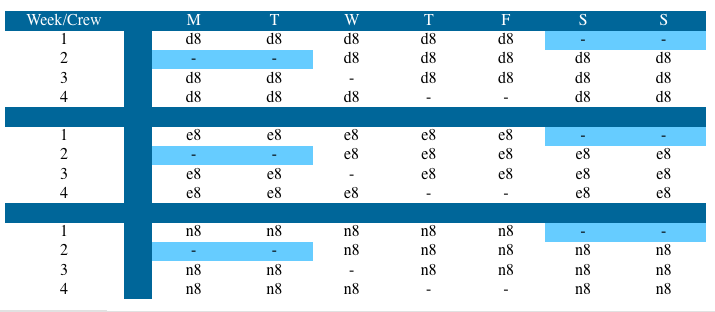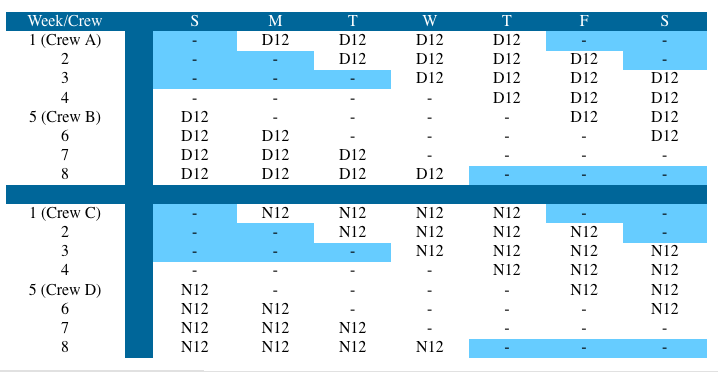Managers, if you want to attract and maintain a quality workforce, find a way to avoid rotating shifts. Employees don’t like them. They are bad for health and alertness. This page discusses how you can take a rotating schedule and make it a fixed shift schedule while maintaining many of the key characteristics of the original rotating schedule.
Shift Schedules #1 and #2 demonstrate two ways to provide 24/7 coverage using rotating shift schedules. While there are advantages to using rotating shift schedules, there are also advantages to using fixed shift schedules. In this topic, we will look at ways to modify Shift Schedules #1 and #2 to make them fixed shift schedules.
Fixed Shift Schedules
On a fixed shift schedule, each crew comes into work at about the same time every day they are scheduled to work. In other words, crews are assigned to work day shift only, afternoon shift only, or night shift only. Modifying Shift Schedules #1 and #2 to meet this definition results in:
Shift Schedule #1 – Fixed Shifts

d8 = 8-hour day shift
e8 = 8-hour evening shift
n8 = 8-hour night shift
– = Day off (Full weekends off are highlighted)
This shift schedule is staffed with three crews – one on day shift, one on a night shift, and one on the evening shift. Each crew works a four-week cycle staffed by four sub-crews equal in size to 1/3 of the staffing needed on shift at any one time. Each sub-crew is assigned to start their schedule in a different week in the cycle. At the end of each week, all sub-crews move down to the next week in the cycle (or return to Week 1), but never rotate to another shift.
Each crew is divided into four sub-crews so that the staffing levels are equal every day of the week. On any given workday three out of four of the sub-crews on each shift are working, and one sub-crew on each shift is off.
Business Issues
Using sub-crews has important implications for how the schedule is managed. While it is needed to provide balanced coverage, it raises some questions:
- How does the schedule affect the teams in the organization?
- How do we supervise this schedule?
- How do we cover single, high-skilled positions without “over-skilling” the crews?
- Can we communicate with all of a crew at once?
- What if the number of people on a shift is not a multiple of three? Will this schedule even work?
- Many of these issues have solutions, but they do add some complications to the schedule management systems. Other business issues include:
- Every day is covered by nine sub-crews working, with three sub-crews from each working crew on a different shift (i.e. 24-hour coverage).
- Since 8-hour shifts have been the “standard” for so long in many countries, the pay and work policies and union contracts in use today will often work without modification on this schedule.
- Week 3 normally results in increased costs for overtime premiums.
Employee Issues
- Built-in overtime and shift premiums result in increased compensation relative to many day-workers.
- There are about 273 workdays each year.
- Only one weekend out of four is off (13 weekends off each year). Each weekend off is four days long.
- Fixed shifts avoid most of the circadian rhythm issues for the first and second shifts. Since personnel working a third shift often try to spend their time off on a day-shift routine, they still rotate their biological clocks.
- Working seven consecutive shifts is tiring.
- Working 14 out of 15 days in weeks two and three is also tiring.
- Overtime is normally worked on a scheduled workday, making time-off relatively predictable.
Modifying Shift Schedule #2 to be a fixed shift schedule results in:
Shift Schedule #2 – Fixed Shifts

D12 = 12-hour day shift
N12 = 12-hour night shift
– = Day off (Full weekends are highlighted)
This shift schedule is an eight-week cycle staffed by four equal crews (note that sub-crews are not required like they were in the fixed version of Shift Schedule #1). Each crew is assigned to start their schedule in a different week in the cycle as shown above. At the end of each week, all crews move down to the next week in the cycle (or return to Week 1). A and B crews work day shifts only, and C and D crews work night shifts only.
Since crews do not need to be split into sub-crews to provide equal coverage on all shifts, this schedule does not face the issues discussed above for Shift Schedule #1.
Business Issues
- Every day is covered by two crews working, with each working crew on a different shift (i.e. 24-hour coverage). The other two crews are off. This allows your operations to be covered continuously with full crews.
- There are two shift handoffs each day. This often improves communication during the four days that the same crews are working–information is received from and passed on to the same person each day.
- Pay and work policies usually must be modified to fit the schedule. Traditional policies are often based on 8-hour shifts worked Monday through Friday. If these policies are not adjusted, shift schedule administration is complex and may appear to be illogical.
- Absence management systems must change. If personnel are not available on-shift to cover for illness and other unscheduled absences, personnel on their day off are needed to provide the proper coverage. While this is different than holding personnel over or calling them early on a workday, it usually does not reduce the actual number of days off significantly.
- Half of the workweeks are 36 hours long, and the other half are 48 hours long. In the United States, this results in increased overtime premiums and costs relative to a schedule with balanced workweeks. In countries where workweeks can be averaged (like Canada and Australia), this is not a problem.
Employee Issues
- Built-in overtime and shift premiums result in increased compensation relative to many day-workers.
- There are 182 workdays each year.
- There are 19-20 full weekends off each year (depending on the year), and 12-13 half weekends off. The weekends off are grouped together, with three consecutive weekends off followed by five weekends where at least one day must be worked.
- All breaks are four days long. Shift workers tell us that this is one of the best features in this shift schedule.
- Like Shift Schedule #1, the fixed shifts minimize the circadian rhythm issues for the day-shift personnel. The night shift personnel will probably still rotate sleeping time between days and nights when they transition from days off to workdays.
- Working four consecutive 12-hour shifts in a row is tiring. However, the extra days off often allow shift workers to get more sleep overall. Overtime is normally worked on a scheduled day off. This can lower schedule predictability if it is not properly managed.
- Workweeks are unbalanced. This results in four consecutive weeks of pay for 36-hour weeks and four consecutive weeks of pay for 48-hour weeks. This normally results in unbalanced paychecks.
These are some of the issues that employers and employees with this schedule face. Other issues and variations on these schedules include:
- Lunches may be paid or unpaid – unpaid lunches may result in idle time at shift change.
- Start times may vary
- Staffing on each shift may vary according to need
- Weekend staffing may differ from weekday staffing
- Night shifts may be the first or last shift of the day
Call Us and We Can Help
Call or text us today at (415) 763-5005 to discuss your operations and how we can help you solve your shift work problems. You can also complete our contact form and we will call you.

